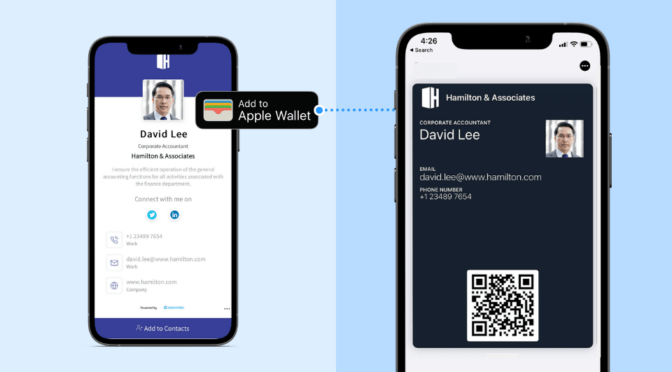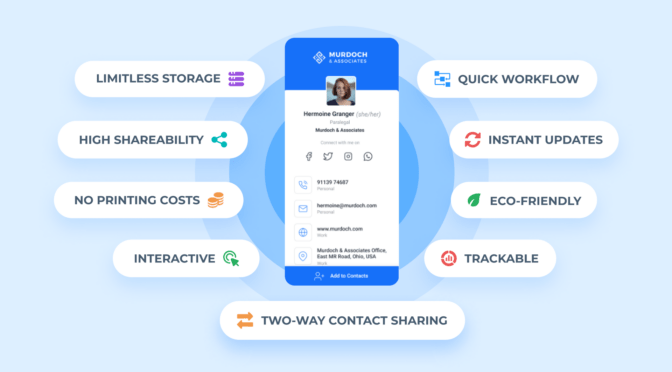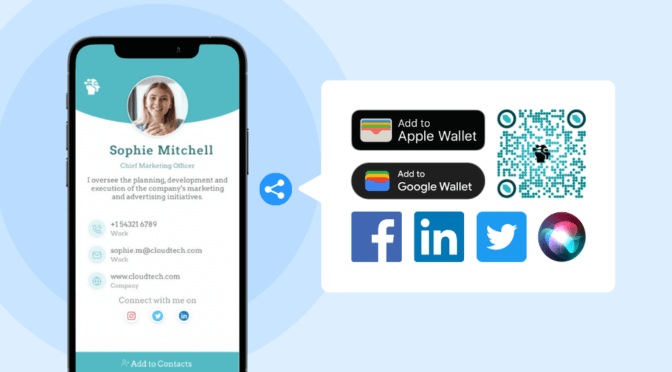First impressions often depend on the details you share. But when it comes to a business card, figuring out what to put there can be tricky—there’s limited space to convey everything you want about yourself or your business. Yet, you must put enough information that prompts the recipient to take the action you want them to take.
Learn what information you can put on a business card to get the most out of it. This article will also discuss the best ways to increase your networking ROI with business cards.
- What information to put on a digital business card: The 6 vital details
- How to improve networking ROI with business cards
- What information to include on a business card: By different sectors
- How to create a digital business card with all your desired contact information
- Create a lasting impression with your business cards
- Frequently asked questions
What information to put on a digital business card: The 6 vital details
Below are the six must-have details to put on a professional digital business card:
1. Name:

It might seem like a no-brainer, but include your name prominently at the top and center of your business card.
A name fosters personalization. It transforms a generic piece of marketing material into a direct introduction to you as an individual. Seeing your name prominently on the card reminds the recipient that they connected with a person, not just a company logo. If there is enough space in your card, consider adding a headshot.

2. Contact details: phone number and email address
After looking at your business card, your recipients know your name, and now you’d want to ensure they can easily reach out to you.
This is where your contact details come in handy. Your phone numbers and email addresses must be clearly stated. Use the following categories to appoint a designation to the relevant virtual phone number for your recipient:
- Work
- Mobile
- Personal
- Home
- Fax
- Page
Furthermore, you can assign the following categories to your email addresses:
- Work
- Personal
- Other

3. Company name and designation
Adding the company name and designation is best, even if you use your company logo. Including your company name provides context for your expertise, and your designation clarifies your role within the company.
For instance, knowing if you’re a “Marketing Director” or a “Sales Associate” helps the recipient understand your specific area of expertise and how you can potentially benefit them. It also provides essential context for your role, builds trust, and helps you make a more impactful professional connection.
4. Professional summary
After your designation, a well-crafted professional summary highlights your key skills and experience. It also clarifies what you do in the role, and if that matches with a recipient’s potential requirements.
Further, your summary can be tailored to specific networking events or target audiences. For example, a short professional summary for the post of “Marketing Director” can read as follows:
“I drive brand awareness campaigns and revenue at <company name>. I have <number of years> of experience crafting compelling brand narratives and executing omnichannel strategies.” The idea here is to remain concise in your wording. So, summarize the text to save up space on your digital business card and make things easier for others to read and understand.
5. Brand logo and brand design

The importance of a brand logo needs no explanation. So, ensure that every digital business card you create includes a company or brand logo. You can also be as thorough as possible with font styles, text sizes, and color elements. This ensures that your e-business card perfectly reflects your branding.
6. Website
A website is often a brand’s primary resource for establishing and demonstrating an online presence. You can add as many website links as needed, labeling them as:
- Personal
- Company
- Work
- Social
- Portfolio
- Others
Try to include a simple URL that’s easy to manually search online. Ensure that the website is highly relevant to your recipient. Well-thought-out website designs can make navigation intuitive, ensuring visitors find the necessary information quickly.
How to improve networking ROI with business cards
Networking is one of the best ways to connect, capture, and generate leads. Let’s explore strategies to maximize your networking ROI through effective business card utilization.
1. Keep your business cards clutter-free
According to survey data, 40% of the participants had a bad impression because of the design and quality of a business card. It’s clear that a clean and minimalist business card design ensures that people have a good impression and the essential information is easily readable.
Avoid overcrowding the card with too many details or excessive graphics. Focus on including your name, job title, company logo, and contact information. In the same survey, 40% of respondents preferred a no-frills layout with just the accurate company details in a business card. You can never go wrong with a simple, well-organized layout that can help recipients quickly find the necessary information and remember who you are.
2. Consider using digital business cards
Consider you are at a conference and have run out of paper business cards. Or, you’re busy networking and notice at the last minute that the information on your card is outdated. With your traditional card, you’d probably panic. But this is where digital business cards can be a lifesaver.
A virtual business card (digital business card) can be created easily with the right platform. Moreover, you can always revisit them and update your information whenever required.
Digital business cards significantly enhance networking ROI by using interactivity and real-time tracking. According to Salesforce, 6 out of 10 consumers prefer digital interactions for convenience, which translates into higher engagement rates for digital business cards than traditional paper ones.
There are multiple benefits of digital business cards. They are as follows:
- Instantly access your contact information with a simple click or tap
- View your business location on a map and get directions
- Explore your social media profiles with direct links to your platforms
- Engage with additional content like videos, portfolios, or online booking options
- Save your contact details for easy reference later
- Track and measure engagement for valuable insights
3. Follow-up promptly
After exchanging business cards, timely follow-up is essential to cement the initial connection. Within a day or two, send a brief email or LinkedIn message to remind the recipient of your meeting and express your interest in continuing the conversation. This prompt action demonstrates your professionalism and eagerness to build a relationship, increasing the chances of a successful networking outcome.
⚡Pro tip: Consolidate client data with Uniqode’s digital address book and integrate it with your CRMs

- Natively integrate the address book with CRM such as Salesforce to streamline contact management and lead nurturing processes
- Export contacts to CRMs such as HubSpot or Pipedrive via Zapier integration and simplify data organization
4. Personalization
Personalizing your business card can significantly change how a prospect perceives it. Consider including a personal touch, such as a unique design element, a tagline that reflects your personality or business ethos, or even a handwritten note. Just make sure not to overdo anything and keep it minimal and clean.
Personalization helps your business card stand out and conveys that you put thought and effort into making a connection.
What information to include on your digital business card: By different sectors

1. For business professionals
Your digital business card can be the first interaction a potential customer has with you or your professional practice. Thus, it is essential to get your information right the first time.
It is crucial to prioritize contact information on a business card and organize it well for business professionals.
More often than not, when networking, your audience already knows what you do. However, your contact details may not be as readily available to your clients. Ensure you showcase relevant contact information—including all your phone numbers, email addresses, and websites.
For instance, a lawyer’s business card can only display their company’s official website and other contact details. This will prompt prospects to visit the website and find out the necessary information on their own.
2. For influencers
Influencers typically seek social media content, so adding social media handles to business cards can be invaluable for this group of professionals.
For instance, YouTube influencers can include their YouTube channels on business cards to help recipients find their content easily.
Bonus tip: Many social media influencers must maintain consistency in their visual design elements. When creating your digital business cards, you can use Uniqode’s visual customization options to customize your card’s look and feel.
3. For freelancers
Freelancers provide various services, such as graphic design, content writing, accounting, and book-keeping side hustles. But when it comes to what essential information to put on a business card, it all comes down to what can separate you from your competitors.
Apart from convincing profile information that briefly defines your work as a freelancer, it’s crucial to include links to your portfolio website. This can convince your freelancing leads to convert into paying clients.
4. For students
Students can use business cards to build connections for their future careers. Craft a compelling headline that reflects your aspirations, then highlight your academic journey (university, major, graduation year).Showcase your developed skills and consider including a link to your online portfolio if you have one. For professional networking, link to relevant social media profiles like LinkedIn.
Finally, ensure your email and (optional) phone number are easily accessible, allowing potential employers and collaborators to connect with you smoothly.
How to create a digital business card with all your desired contact information
While traditional business cards help foster valuable connections, digital business cards present a paperless, eco-friendly, and more professional alternative.
Here’s your guide to creating a dynamic digital business card loaded with all the information you need to impress:
Step 1: Gather information:
Before diving in, compile all the information you want to include. Think beyond the basics (name, title, contact details) and consider these resources:
- Links to your website, portfolio, or social media profiles.
- A professional headshot.
- A captivating headline that reflects your value proposition
- QR code for easy access to your digital card.
Step 2: Choose your platform
Several online platforms specialize in creating digital business cards. Research and select one that aligns with your needs and budget. Many offer free basic options, while premium plans may unlock additional features.
Step 3: Design and customize
Most platforms offer customizable templates. Unleash your creativity, but remember to prioritize clarity and professionalism. Avoid cluttering your card and know what to not put on a business card.
Step 4: Integrate and share
Once your digital masterpiece is complete, integrate it into your email signature and social media profiles. Share it effortlessly with a tap of your phone or a simple link.
Bonus tip: Regularly update your digital card with any changes to your information, ensuring your connections always have access to the most accurate details.
Create a lasting impression with your business cards
Sharing a business card with all the relevant information puts you in a better position to win more customers and clients.
With Uniqode’s digital business card solution, you can get as comprehensive as you need with your profile information and contact details. You can add as many supplementary links as you want and direct your audience to where you can demonstrate social proof.
Moreover, Uniqode’s extensive visual customizations let you personalize your business card’s design elements. As a result, your digital business card can truly achieve its main goal—to become an extension of you and your brand.
Looking for a feature-based comparison of the best digital business card makers? Check out our guide on the 6 best digital business card solutions available today.

Frequently asked questions
What to put on a business for small businesses?
A business card representing a small business must include the following:
- The representative’s name, company designation, and a summary.
- A high-quality headshot.
- The company’s name and logo.
- Detailed contact information.
- The company’s website and social media handles.
- Business location (if applicable).
- The company’s unique branding elements.
Are digital business cards eco-friendly?
Digital business cards are significantly more environmentally friendly than traditional paper cards. By eliminating the need for paper, printing, and transportation, digital cards help reduce deforestation, waste, and carbon emissions. They offer a sustainable alternative that aligns with eco-conscious values.
Can I use a digital business card offline?
While digital business cards primarily function online, there are ways to access your information offline:
- QR Codes: Include a QR Code on a physical card that links to your digital business card. This allows for easy access to your updated information.
- NFC technology: Some platforms offer NFC-enabled physical cards that contain your digital information, providing an instant connection when tapped with a compatible device.
By combining the convenience of digital technology with offline accessibility, you can ensure your business card is always ready to make a positive impression.
What information should you NOT put on a business card?
Here are the 6 things you shouldn’t include in a professional business card:
- Hard-to-read texts.
- Poor design quality.
- A low-resolution photo.
- Incomplete or outdated contact information.
- Unprofessional content (e.g., jokes and informal language).
- Typographical and grammatical errors.
What should be put on the back of a business card?
Making the back of a business card is also important. If you still use paper cards, consider a QR code for easy digital access, website/social media links, or a short call to action. For more space, showcase services (freelancers/businesses), testimonials, or your company slogan. Keep it clear and avoid clutter. Remember, digital business cards offer a more versatile and updatable alternative.
Kritika is a Senior Content Marketer at Uniqode, where she helps readers navigate networking in a phygital world. She has over 4 years of experience in breaking down complex technology trends into actionable insights for the SAAS domain.Her blogs talk about how business can opt for smarter and sustainable networking practices with digital business cards. When she’s not writing, you’ll probably find her baking something new or hanging out with her dog—who, by the way, has her own digital contact card too.














